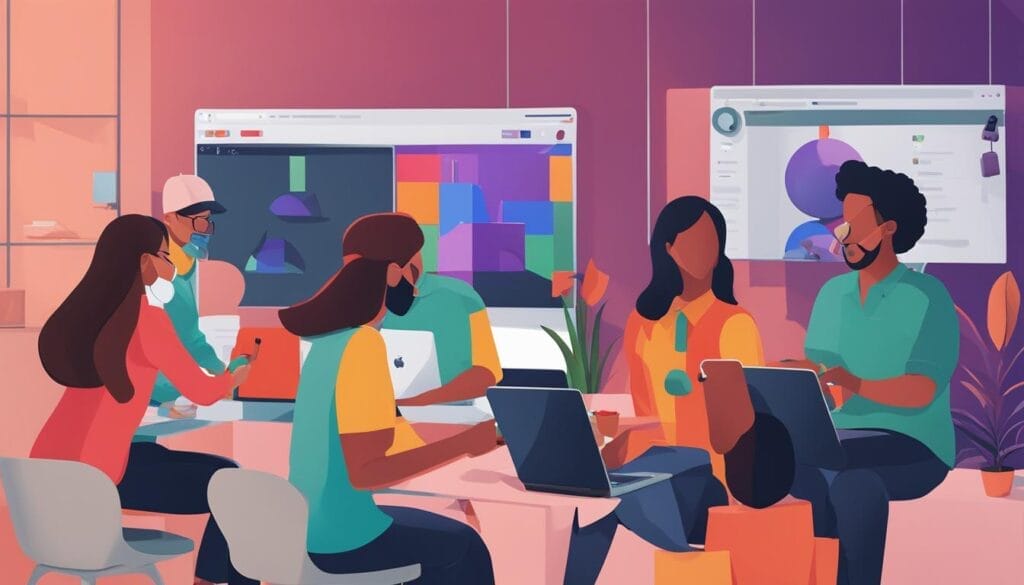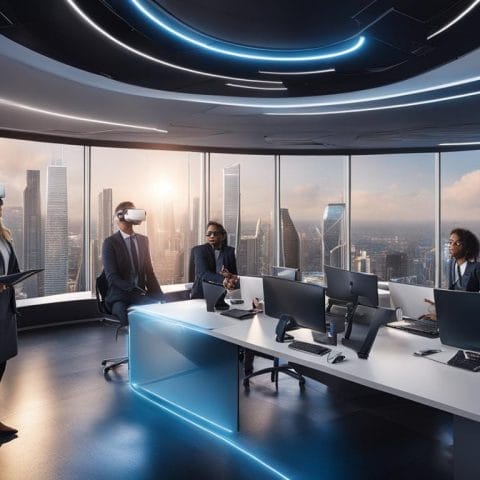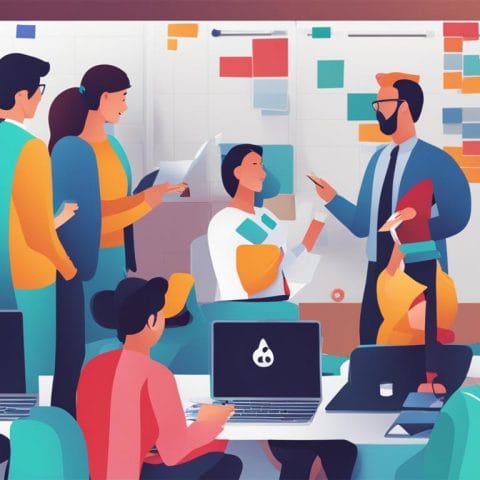Welcome to our article on boosting virtual team creativity in remote workspaces. Contrary to popular belief, remote work can actually enhance innovation and creativity. Extensive research has shown that remote teams have the potential to excel in creative problem solving and generate innovative ideas. In this article, we will explore the best practices and techniques to foster virtual team creativity, enabling teams to thrive in the digital workplace and achieve exceptional results.
Key Takeaways:
- Remote work environments offer unique advantages for creative processes and innovation.
- Adopting virtual brainstorming techniques can unlock the creative potential of remote teams.
- Mindset plays a crucial role in fostering creativity and innovation in remote teams.
- Developing capabilities and infrastructure tailored to remote work promotes team creativity.
- Virtual team-building activities contribute to team synergy and creative collaboration.
The Importance of Mindset for Remote Team Creativity
When it comes to remote team creativity, mindset plays a crucial role in fostering innovation and driving effective remote work. Developing a positive perspective towards creativity is essential for individuals and the team as a whole. By reflecting on our personal and collective mindset regarding creativity, we can overcome obstacles and create an environment that supports robust creativity and innovation.
Factors that can hinder creativity in remote teams include:
- Excessive meetings that consume valuable time and limit deep work focus.
- Overwork and burnout, which can deplete creative energy.
- Feelings of isolation that hamper collaboration and idea sharing.
- Lack of psychological safety and trust, inhibiting creative expression.
- Fear of change, which stifles experimentation and new ideas.
By recognizing and addressing these factors, leaders can establish a remote or hybrid environment that nourishes remote team creativity and unleashes innovative thinking.
“The only thing that stands between a person and what they want in life is the will to try and the faith to believe it is possible.” – Rich Devos
By assessing what drives creativity and innovation in your team, you can:
- Identify the strengths and weaknesses of your team’s creative mindset.
- Implement strategies to enhance creativity and innovation.
- Create a safe space for experimentation and the freedom to fail.
- Foster a culture that values and rewards creative thinking.
- Encourage open communication and idea sharing.
By prioritizing mindset and cultivating a creative atmosphere, remote teams can unlock their full creative potential and drive impactful innovation.
| Mindset Obstacles | Ways to Overcome |
|---|---|
| Excessive meetings | Schedule fewer, more focused meetings and embrace asynchronous communication. |
| Overwork and burnout | Encourage work-life balance and provide opportunities for relaxation and rejuvenation. |
| Feelings of isolation | Promote virtual team bonding activities and foster a sense of connection. |
| Lack of psychological safety and trust | Create an inclusive and supportive environment where all ideas are welcomed and respected. |
| Fear of change | Encourage a growth mindset and embrace experimentation and adaptation. |
Developing Capabilities for Remote Team Creativity
Developing habits that cultivate remote team creativity is crucial for unleashing the full potential of virtual workspaces. By prioritizing virtual work and embracing async-first practices, remote-first teams can create an environment that maximizes deep thinking, inspiration, and idea generation.
In remote work, team members have the opportunity to engage in deep thinking, reflection, breaks, research, and reading without the constraints of traditional office settings. This allows for uninterrupted focus and the exploration of new ideas. Leveraging the different environments experienced by dispersed team members can foster fresh perspectives and innovative approaches to problem-solving.
The Role of Psychological Safety and Collaboration
Promoting psychological safety within remote teams is essential to encourage open and inclusive conversation, brainstorming, and collaboration. When team members feel safe to express their thoughts and opinions without fear of judgment or negative consequences, they are more likely to share their ideas and contribute to the creative process.
Psychological safety is the belief that one will not be punished or humiliated for speaking up with ideas, questions, concerns, or mistakes. – Amy Edmondson
In virtual environments, it is crucial to provide tools and platforms that level the playing field for idea generation and brainstorming. This ensures that all team members have equal opportunities to contribute and be heard. Collaborative tools that facilitate real-time collaboration, document sharing, and idea tracking can enhance team creativity and innovation in virtual settings.
Creating a Virtual Environment of Inspiration
To foster creativity and inspiration in remote teams, it is important to create virtual environments that stimulate the imagination and provide a sense of connection. Incorporating visual elements, such as virtual backgrounds or shared mood boards, can help create a stimulating atmosphere for idea generation and exploration.
Additionally, regular virtual check-ins and brainstorming sessions can provide an opportunity for team members to collaborate and bounce ideas off each other. These virtual gatherings can mimic the energy and excitement of in-person brainstorming sessions, leading to increased creativity and innovation within the team.
By developing the capabilities necessary for remote team creativity, organizations can unlock the full potential of their virtual workspaces and drive meaningful innovation. Prioritizing deep thinking, psychological safety, collaboration, and inspiration can create a culture of creativity that propels remote teams towards innovative solutions and breakthrough ideas.
Creating Infrastructure for Remote Team Creativity
Establishing an infrastructure that supports remote team creativity is essential. Remote workspaces play a crucial role in maximizing the benefits of remote work, providing the time and space needed for creative thinking and collaboration. Virtual collaboration tools and platforms offer a range of features and functionalities that facilitate seamless communication and idea exchange. These tools enable remote teams to overcome the challenges of physical distance and create a cohesive virtual environment.
While “watercooler moments” may not contribute directly to innovation, they offer opportunities for serendipitous interactions and informal conversations that can foster creativity and spark new ideas. Embracing synchronous time, where team members can gather virtually at designated times for casual discussions or brainstorming sessions, helps recreate the spontaneous collaboration often found in traditional office settings.
Constraints, such as time limits and breaks, can actually boost creativity by promoting focused and efficient work. Setting aside dedicated deep work sessions allows remote team members to immerse themselves in complex tasks that require uninterrupted concentration. These deep work sessions provide the necessary conditions for innovation and breakthrough thinking.
Virtual Brainstorming and Idea Management
Virtual brainstorming is a powerful technique for generating innovative ideas in remote teams. Through virtual collaboration tools, team members can contribute their thoughts and ideas in real-time, creating a dynamic and inclusive brainstorming session. These tools often provide features like virtual whiteboards, sticky notes, and chat functionalities, enabling efficient idea sharing and collaboration across geographical boundaries.
Keeping track of ideas becomes crucial in remote team settings where ideas can easily be lost or forgotten. Implementing virtual idea management systems or project management tools allows team members to capture, organize, and track ideas throughout the innovation process. This not only facilitates collaboration but also ensures that promising ideas are not overlooked.
Below is an example of a table showcasing different virtual collaboration tools and their key features:
| Virtual Collaboration Tool | Key Features |
|---|---|
| Slack | Real-time messaging, channels for teams and projects, integration with other tools |
| Trello | Visual project management, task assignment, progress tracking |
| Miro | Virtual whiteboard, sticky notes, collaboration features |
Creating a Space for Deep Work
Remote team creativity thrives in an environment that supports deep work. Deep work sessions are periods of focused and uninterrupted concentration on cognitively demanding tasks. To facilitate deep work, remote teams can establish guidelines and norms that protect deep work time, minimize distractions, and prioritize quality over quantity.
Virtual workspaces can be designed to prioritize deep work by offering features like “Do Not Disturb” modes, customizable notifications, and integrations with time management tools. These virtual workspaces create an immersive and distraction-free environment that is conducive to deep thinking and creative problem-solving.
By creating a supportive infrastructure that combines synchronous collaboration, serendipitous interactions, constraint-driven focus, and virtual collaboration tools, remote teams can unleash their full creative potential and drive innovative outcomes.
Schedule Watercooler Breaks and Ice Breaker Activities

Creating opportunities for casual conversations and team bonding is crucial in virtual teams. Watercooler breaks can be scheduled to recreate the informal atmosphere of a physical office and foster connections among team members. These breaks provide an invaluable chance to engage in conversations about topics other than work, allowing team members to get to know each other on a personal level and build a sense of camaraderie.
Additionally, organizing ice breaker activities can further enhance team connection and boost morale. Ice breakers can range from simple games or trivia sessions to interactive challenges that encourage teamwork and collaboration. These activities serve as a fun and engaging way for team members to break the ice, strengthen relationships, and create a positive team culture.
By incorporating watercooler breaks and ice breaker activities into the virtual team’s schedule, leaders can promote team cohesion and foster a supportive and inclusive work environment. These small gestures go a long way in nurturing team morale and building strong relationships, ultimately contributing to a more productive and connected virtual team.
Remote Office Live Stream and Virtual Happy Hour
Creating a virtual office live stream is a fantastic way to bring team members together in a virtual environment that mimics the experience of being in a physical office. Through live streaming, team members can join a video chat or virtual meetup and engage in casual conversations, just like they would during coffee breaks or lunchtime chats in an office setting. This creates a sense of camaraderie and fosters team bonding and connection even in remote workspaces.
Additionally, scheduling virtual happy hours can further enhance team bonding and foster a sense of togetherness. Team members can enjoy a drink or treat of their choosing while participating in online games, interactive activities, and simply engaging in casual conversation. These virtual happy hours provide a relaxed and fun environment for team members to unwind, socialize, and strengthen their relationships. It’s a time for laughter, shared experiences, and genuine connection.
By incorporating live streaming and virtual happy hours into the remote work routine, organizations can bridge the physical distance between team members, creating opportunities for team bonding and team connection. These activities not only foster a positive and collaborative work culture, but they also contribute to the overall well-being and happiness of the team.
Check out the image below to visualize the concept of a virtual office live stream:
| Benefits of Live Streaming and Virtual Happy Hours |
|---|
| 1. Simulates the experience of being in an office |
| 2. Fosters team bonding and connection |
| 3. Provides a relaxed and fun environment |
| 4. Strengthens relationships |
| 5. Boosts overall team well-being |
Virtual team building activities like live streaming and virtual happy hours play a crucial role in maintaining team connection and fostering a sense of belonging in remote work settings. They allow team members to interact, engage, and enjoy each other’s company, regardless of physical location. By embracing these virtual team-building strategies, organizations can ensure that their virtual teams thrive and continue to collaborate effectively, ultimately leading to increased productivity and success.
Virtual Scavenger Hunt and Personality Assessments for the Workplace

Looking for a fun and engaging team-building activity that can be done virtually? Consider organizing a virtual scavenger hunt! This exciting game allows team members to take a break from their work and collaborate in a lighthearted and interactive way. By encouraging teamwork and problem-solving skills, virtual scavenger hunts can strengthen bonds among team members and enhance overall team collaboration.
Here’s how it works:
- Create a list of items or clues that team members need to find or solve.
- Assign teams or pair up team members to work together.
- Set a time limit for the scavenger hunt and provide instructions on how to submit their findings.
- Host a virtual meeting to kick off the scavenger hunt and explain the rules.
- During the allotted time, team members search their homes or surroundings for the items or clues.
- Once the time is up, reconvene the team and have each group share their findings and experiences.
Not only does a virtual scavenger hunt offer an opportunity for team bonding and fun, but it also provides a break from work and promotes a positive team atmosphere. To further enhance team collaboration and communication, consider incorporating personality assessments into your virtual team-building activities.
Personality assessments, such as the DISC or Myers-Briggs Type Indicator (MBTI), can help team members gain insights into their own behaviors and preferences. By understanding their teammates’ personalities, individuals can adapt their communication styles and work together more effectively. Personality assessments can also foster empathy and appreciation for the unique strengths each team member brings to the table.
Benefits of Personality Assessments:
- Improved Communication: Personality assessments can reveal different communication styles and preferences, helping team members understand how to effectively communicate with one another.
- Enhanced Collaboration: By understanding each other’s strengths and weaknesses, team members can collaborate more efficiently and leverage their individual skills.
- Conflict Resolution: Personality assessments provide insight into potential sources of conflict and enable teams to address conflicts more constructively.
Integrating virtual scavenger hunts and personality assessments into your remote team-building activities can have a positive impact on team collaboration and bonding. These activities add an element of fun and allow team members to connect on a more personal level, even when physically separated.
Remember, it’s important to tailor the activities to your team’s preferences and needs. Get creative, have fun, and watch your team’s collaboration and bonding soar!
| Benefits of Virtual Scavenger Hunts: | Benefits of Personality Assessments: |
|---|---|
| 1. Encourages team bonding | 1. Improved communication |
| 2. Promotes collaboration | 2. Enhanced collaboration |
| 3. Provides a break from work | 3. Conflict resolution |
| 4. Strengthens team relationships |
Challenge Remote Employees and Lunch and Learn Sessions
One effective way to promote personal growth and accountability within remote teams is by inviting employees to set goals or challenges for themselves. This not only encourages individual development but also fosters a sense of ownership and engagement within the team. At the end of the day, checking in with remote employees to discuss their progress provides an opportunity for feedback and further motivates them to achieve their goals.
Another valuable virtual team-building activity is organizing Lunch and Learn sessions. These sessions create a space for team members to share their expertise on a specific topic and facilitate learning and collaboration. By encouraging employees to share their knowledge and experiences, Lunch and Learn sessions contribute to the collective growth and continuous learning of the team.
Challenge remote employees and Lunch and Learn sessions are effective strategies for promoting employee engagement, encouraging personal development, fostering team collaboration, and enhancing virtual team building.
Challenge Remote Employees
Challenging remote employees to set goals or take on meaningful tasks can have several benefits for both individuals and the team as a whole. Some advantages of challenging remote employees include:
- Personal growth: Setting and achieving goals helps remote employees develop new skills, improve existing ones, and broaden their knowledge.
- Accountability: By setting clear goals and following up on them, remote employees become more accountable for their work and are more likely to meet deadlines and deliver high-quality results.
- Motivation: Having a challenge or goal to work towards motivates remote employees, increasing their productivity and focus.
Furthermore, by regularly checking in with remote employees, leaders can provide guidance, support, and recognition, creating a positive and supportive work environment.
Lunch and Learn Sessions
Lunch and Learn sessions are an effective way to encourage knowledge sharing, collaboration, and continuous learning within remote teams. These sessions typically involve team members presenting on a specific topic of their expertise during a designated lunchtime.
- Knowledge sharing: Lunch and Learn sessions allow team members to share their insights, experiences, and expertise on various subjects. This promotes cross-functional learning and helps team members acquire new skills and knowledge related to different areas of the business.
- Collaboration: By engaging in Lunch and Learn sessions, remote team members have the opportunity to collaborate, ask questions, and exchange ideas with their colleagues. This collaboration enhances teamwork and fosters a culture of innovation and learning.
- Employee engagement: Providing a platform for team members to share their knowledge and interests increases their engagement and sense of belonging within the team. Lunch and Learn sessions demonstrate that their expertise and contributions are valued.
Lunch and Learn sessions can cover a wide range of topics, such as industry trends, new technologies, best practices, or personal development strategies. The sessions can be hosted by different team members on a rotating basis, ensuring a diverse range of subjects are explored.
| Benefits of Challenge Remote Employees | Benefits of Lunch and Learn Sessions |
|---|---|
|
|
Workout, Meditate, or Dance Together Over Video and Virtual Movie Night
Encouraging team members to engage in wellness activities together is a great way to foster team bonding and enhance overall well-being. Whether it’s doing workouts, meditating, or dancing over video calls, these activities promote a sense of connection and camaraderie among virtual teams.
Virtual workouts allow team members to stay active and healthy while working remotely. They can choose to participate in live fitness classes or follow pre-recorded workout videos. By exercising together, team members not only prioritize their physical well-being but also support and motivate each other on their fitness journeys.
Meditation sessions are another valuable wellness activity for virtual teams. Guided meditation sessions can help team members reduce stress, improve focus, and enhance their mental well-being. By meditating together, team members can create a calming and supportive environment that fosters a positive mindset and a sense of unity.
Additionally, organizing virtual dance sessions can add a fun and energizing element to team building. Dancing is not only a great way to get moving but also allows team members to express themselves creatively. By dancing together over video, virtual teams can let loose, have fun, and share joyful moments.
“Wellness activities like workouts, meditation, and dancing over video help promote team bonding, foster a sense of belonging, and improve overall team wellness.” – Anonymous
In addition to wellness activities, virtual movie nights provide a relaxing and enjoyable experience for remote teams. Team members can choose a movie to watch together and use video conference software to synchronize their viewing. This virtual movie night allows team members to unwind, enjoy a shared experience, and engage in casual conversations, fostering team bonding and creating memorable moments of connection.
Benefits of Workout, Meditation, and Dance Activities:
- Promotes team bonding and camaraderie
- Enhances overall well-being
- Reduces stress and improves mental health
- Increases physical fitness and energy levels
- Encourages creativity and self-expression
- Creates opportunities for shared experiences
By incorporating workout, meditation, and dance activities into virtual team-building initiatives, teams can strengthen their connections, boost their wellness, and foster a positive and collaborative remote work culture.
Invest in Continuous Learning and Development, and Foster a Culture of Creativity
Continuous learning and development opportunities play a crucial role in nurturing the creative potential of remote teams. By investing in networking events, training workshops, and mentorship programs, organizations can empower their employees to expand their knowledge and skills, ultimately fueling innovation. Emphasizing continuous learning and development helps remote teams stay motivated, engaged, and open to new ideas.
Creating a culture that promotes creativity is equally important for remote teams. A culture that values imaginative thinking and encourages fresh perspectives fosters a sense of ownership and empowerment among employees. When creativity is embedded in the team’s DNA, individuals feel inspired to contribute their unique ideas, leading to a more innovative and dynamic work environment.
In addition to continuous learning and creativity, it’s essential to prioritize employee wellness and work-life balance within remote teams. The well-being of team members directly impacts their productivity and creativity. When employees feel supported and have a healthy work-life balance, they are more likely to be motivated, focused, and energized, which positively impacts the overall creative output of the team.
| Benefits of Investing in Continuous Learning and Development and Fostering a Culture of Creativity |
|---|
| 1. Enhanced employee motivation and engagement |
| 2. Increased innovation and idea generation |
| 3. Improved employee satisfaction and retention |
| 4. Creation of a positive and dynamic work environment |
| 5. Boosted team collaboration and synergy |
Investing in continuous learning and development, fostering a culture of creativity, and prioritizing employee wellness and work-life balance are crucial components for remote teams seeking to unlock their full potential.
Leverage Technology and Innovation, and Provide Cross-Training and Collaboration
Embracing technology and innovation is crucial for remote teams to collaborate effectively and unlock their creativity. By utilizing cutting-edge tools and platforms, remote teams can streamline their collaboration and tap into breakthrough ideas. Video conferencing enables face-to-face communication, eliminating the barriers of distance and fostering a sense of connection. Task management platforms help teams stay organized, track progress, and manage deadlines. Communication tools provide seamless channels for open communication and exchange of ideas.
One of the key benefits of remote work is the ability to bring together team members with diverse backgrounds and skill sets. Cross-training and collaboration among team members from different projects and processes can foster a fresh perspective and drive collective creativity. This cross-pollination of ideas and expertise promotes innovation and encourages out-of-the-box thinking.
“Technology can be our best friend when it comes to unleashing creativity and fostering collaboration in a remote team environment.”
In addition to leveraging technology and encouraging collaboration, open communication plays a vital role in remote team innovation. Creating a culture of transparent communication where team members feel comfortable sharing their thoughts and ideas leads to deeper collaboration and increased creativity. Regular check-ins, virtual brainstorming sessions, and feedback loops enhance communication and ensure that everyone is aligned towards achieving the team’s goals.
By combining the power of technology, cross-training, and collaboration with open communication, remote teams can unlock their full innovative potential and drive remarkable results.
Benefits of Leveraging Technology and Innovation:
- Streamline collaboration and enhance communication
- Break down barriers of distance and foster connection
- Track progress, manage deadlines, and stay organized
- Enable cross-training and knowledge sharing
- Promote out-of-the-box thinking and innovation
Guidelines for Effective Remote Team Collaboration:
- Utilize video conferencing for face-to-face communication
- Implement task management platforms to stay organized
- Adopt communication tools for seamless exchanges of ideas
- Promote cross-training and knowledge sharing
- Cultivate a culture of open and transparent communication
| Technology and Innovation | Cross-Training and Collaboration | Open Communication |
|---|---|---|
| Streamline collaboration and communication | Foster a fresh perspective and collective creativity | Encourage sharing of thoughts and ideas |
| Eliminate barriers of distance | Promote out-of-the-box thinking and innovation | Ensure alignment towards team goals |
| Enhance knowledge sharing and expertise | Drive remarkable results | Foster a collaborative and inclusive environment |
Conclusion
Remote work does not inhibit creativity and innovation; in fact, it can be an advantage. By fostering a positive mindset, developing capabilities, creating infrastructure, and implementing virtual team-building strategies, remote teams can boost virtual team creativity, remote teamwork, online collaboration, and achieve innovative outcomes.
Embracing technology plays a crucial role in facilitating effective communication, seamless collaboration, and efficient workflow in remote environments. Tools such as video conferencing, task management platforms, and communication tools enable remote teams to collaborate effectively and enhance their creativity. Prioritizing open communication ensures that ideas flow freely and valuable insights are shared, further fueling the creativity and innovation of the team.
In addition, supporting employee well-being is paramount in creating a culture of creativity in remote workspaces. Remote teams should focus on nurturing a work-life balance, encouraging breaks, and providing opportunities for continuous learning and development. By cultivating a positive and inclusive culture that values the well-being of its members, remote teams can thrive creatively, achieve remarkable results, and foster a sense of connection and fulfillment among team members.
FAQ
How can remote workspaces boost virtual team creativity?
Remote workspaces can boost virtual team creativity by prioritizing virtual work, embracing async-first practices, leveraging different environments, and using tools that enhance idea generation and inclusive conversation.
What is the importance of mindset for remote team creativity?
The mindset regarding creativity and innovation dramatically influences the ability to innovate in remote teams. By developing a positive perspective and addressing factors that hinder creativity, leaders can establish a remote or hybrid environment that supports robust creativity and innovation.
How can capabilities be developed for remote team creativity?
Developing capabilities for remote team creativity involves prioritizing virtual work, embracing deep thinking and reflection, creating psychological safety and trust, and utilizing tools and techniques that enhance idea generation and collaboration.
What type of infrastructure supports remote team creativity?
The infrastructure that supports remote team creativity includes virtual workspaces that provide time and space for creative thinking and collaboration, as well as implementing structured breaks, constraints, and virtual collaboration tools that facilitate deep work sessions and idea tracking.
How can watercooler breaks and ice breaker activities enhance remote team creativity?
Watercooler breaks and ice breaker activities can recreate the informal conversations and foster team connection in remote teams. These activities provide opportunities for team members to connect, talk about non-work topics, and create a sense of camaraderie, ultimately contributing to enhanced creativity and team morale.
How can virtual office live streams and virtual happy hours promote remote team creativity?
Virtual office live streams and virtual happy hours mimic the experience of being in a physical office, allowing team members to connect, take breaks together, and engage in informal conversations. These activities promote team bonding and connection, which can enhance remote team creativity.
How do virtual scavenger hunts and personality assessments contribute to remote team creativity?
Virtual scavenger hunts provide a fun way for team members to take a break, engage in team-building activities, and foster creativity. Personality assessments help team members learn more about themselves and their teammates, leading to improved collaboration and communication, which in turn boosts remote team creativity.
How can challenging remote employees and lunch and learn sessions promote remote team creativity?
Challenging remote employees and organizing lunch and learn sessions encourage personal growth, accountability, and knowledge sharing within the team. These activities foster learning, collaboration, and innovation, contributing to remote team creativity.
What wellness activities enhance remote team creativity?
Engaging in wellness activities together, such as workouts, meditation sessions, or dancing over video, promotes team bonding, well-being, and enhances creativity. Virtual movie nights also provide an opportunity for relaxation, connection, and inspiration, ultimately fostering remote team creativity.
How does continuous learning and development foster a culture of creativity in remote teams?
Investing in networking events, training workshops, and mentorship programs nurtures the creative spirit of employees and ensures they stay motivated and innovative. Supporting employee well-being and work-life balance also contributes to a culture of creativity in remote teams.
How can technology and innovation boost remote team creativity?
Embracing technology and innovation enables remote teams to collaborate effectively and enhance their creativity. By using video conferencing, task management platforms, and communication tools, remote teams can streamline collaboration and generate breakthrough ideas. Cross-training and collaboration among team members from different projects and processes also fosters a fresh perspective and drives collective creativity.
Does remote work inhibit creativity and innovation?
Remote work does not inhibit creativity and innovation. In fact, by fostering a positive mindset, developing capabilities, creating infrastructure, and implementing virtual team-building strategies, remote teams can boost creativity, collaboration, and achieve innovative outcomes.





